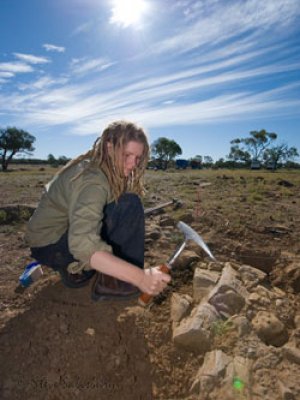
Palaeontologists have discovered a new species of fossilised wood in Winton, providing insight into dinosaur landscapes in central-western Queensland.
University of Queensland researchers have dated the fossils at 92 to 94 million years old and have used them to identify the nature of the ancient landscape.
UQ School of Biological Sciences PhD candidate Tamara Fletcher said wood fossils provided new information about outback Queensland during the early part of the Late Cretaceous Period.
“The grassy plains of central-western Queensland today are quite different from the forests that once existed there,” she said.
“The wood fossils indicate that these forests were dominated by a previously unknown species from an ancient group similar to modern podocarps - a large family of evergreen trees and shrubs that includes the modern plum pine.
“Much like trees today, the growth rings in fossil wood can provide a record of the climatic conditions that a tree experienced while it was alive.
“The wood fossils we found suggest this one wood species dominated the canopy in forests around where Winton is now, and that it was likely an area subject to flooding.”
Ms Fletcher said most wood decayed without leaving a trace in the fossil record.
“Under the right conditions however, dissolved silica in the surrounding mud or sand can slowly permeate the wood,” she said.
“The silica solution replaces the original cell walls, crystallising as quartz to form a fossil with a surprising level of detail.
“The process can be so exact that every detail of the wood’s original surfaces is preserved, and sometimes even the internal cell structures and growth rings.”
Study co-author Dr Steve Salisbury, from UQ’s School of Biological Sciences, said the new species had been named Protophyllocladoxylon owensii in honour of the Mayor of Longreach Regional Council, Joe Owens.
“This fossilised wood is really solid stuff; sledge-hammers bounce straight off it,” he said.
“It’s tough, reliable and easy to find if you know where look—those qualities reminded us of Joe, who has been a strong supporter of our team’s research in the area for over a decade.”
The research is published online in the Review of Palaeobotany and Palynology .
Media: Tamara Fletcher, 0404 907 321, tamara.l.fletcher@gmail.com; Dr Steve Salisbury, 3365 8548 or 0407 788 660, s.salisbury@uq.edu.au
.jpg)









